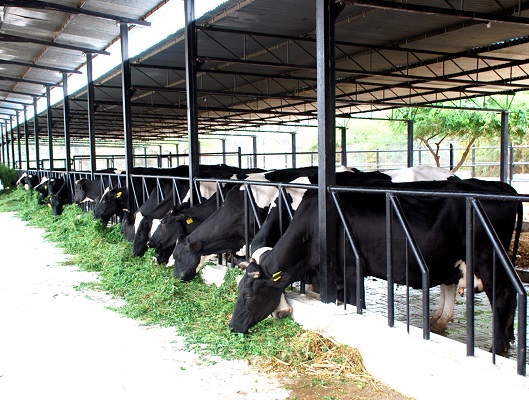

The adverse effects of heat stress on beef cattle are seen at higher temperature–humidity index compared with dairy cattle. These differences are due to breeds characteristics, production, metabolism, feeding plans, and management systems. In fact, the higher threshold temperature for beef cattle is set at 30 °C with relative humidity below 80% and 27 °C with relative humidity above 80%. In contrast to dairy cows, the impact of heat stress on the beef sector is not immediately measurable because it does not reflect on a daily production metric such as milk and may vary depending on several factors. These factors, which will be discussed below, can be summarized by breed, stage of production (e.g., beef cows vs. growing or finishing animals), and production system. Regardless of the cattle category and the production systems, heat stress impairs primarily animal welfare.
Welfare Concern
Heat stress in beef cattle is associated with a higher risk of mortality . Moreover, the negative effects of heat stress on animal welfare can be observed by changes in animal behavior, which include higher respiratory rates and panting scores, decreased rumination period, and higher frequency of drinking. Affected animals are also more inactive, spend less time eating (especially during the daylight hours), and less time in social interactions. These aspects will invariably lead to production losses.
Cattle Breed
Different cattle breeds can cope with heat stress with different magnitudes. For example, there is evidence that Braham cattle (Bos indicus) can better endure thermal stress than B. taurus cattle. Within subspecies, different breeds of B. taurus cattle have different levels of heat tolerance. At this regard, a study by Pereira et al. (2014) demonstrated that Limousine cattle cope better with thermal stress and limit the increase in body temperature with lower thermoregulatory reactions than Holstein Friesians. Moreover, fatter animals and/or with a heavier hair coat (i.e., higher insulation) and/or darker coated animals (e.g., Angus) are more sensitive to heat .
Stage of Production
The beef cattle sector includes the breeding herd and growing/finishing phases, as well as bulls and heifers, which are generally raised in different locations, with different management practices. Therefore, the impact of heat stress also differs between the two cattle categories (nursing/breeding cows and growing animals) affecting mainly the reproductive sphere in the case of the cows, and the carcass yield in the case of the beef, without prejudice to the welfare issue in both cases. Regarding the breeding beef cows, the magnitude of the production losses could be relatively small when the breeding season (as traditionally occurs) coincides with a period of low heat stress. The same could happen in the case of finishing beef when the stressful thermal conditions last for a relatively short period and are followed by sufficient time for the animals to recover by compensatory gain. However, it was demonstrated that beef cattle under heat stress had lower growth rates and, when slaughtered during or immediately after this period, had lower carcass weight, lower fat thickness, and worse meat quality in terms of pH, tenderness, and color.
Production System
Beef cattle are usually raised outdoors and exposed to natural climatic conditions, whereas only a small portion of them are raised in closed housing systems. In general, there are three main beef production systems: pasture based (mainly breeding cows), finishing in outdoor feedlots, and finishing in indoor systems. Depending on the system, different factors can influence the occurrence of heat stress in beef cattle.
The pasture-based system is generally adopted for breeding cows, which are maintained under semi-natural conditions, being on pasture. This semi-extensive system allows the animals to freely adopt coping strategies with weather conditions. These animals usually have some access to shade from trees and the possibility to seek water and air movement to cool themselves.
The feedlot is an outdoor intensive system in which the factors that enhance heat stress are the confinement of cattle in restricted areas that prevent some of their natural coping behaviors (e.g., migration to cooler areas, seeking the protection of shade, etc.) and the high-energy feeding plan. Therefore, specific measures to mitigate heat stress in finishing beef systems are needed, with regard to feed management and pen facilities.
The indoor finishing system is where cattle are housed in roofed facilities where they are kept on fully slatted floors or on deep litter. In this case, direct sun radiation is prevented, but animals face other challenges linked to the change in climate conditions and indoor confinement. In fact, besides the extreme temperature–humidity index conditions, cattle are particularly vulnerable to rapid changes in environmental conditions. Therefore, factors that can influence heat stress in the indoor finishing systems are the high-energy feeding plan and the environmental and micro-climate conditions of the barns. Hence, heat mitigation strategies in this case include changing the feeding plan, providing adequate water supply (possibly by additional water stations), and adoption of cooling systems, such as ventilation.
In view of the present climate changes, therefore, we need to cope with the increase in global temperature that threatens to affect cattle-derived food production. Consequently, to maintain the quantity and quality of milk and meat products, it will be necessary to modify management systems to adapt to the new climatic conditions. Management options include acting at different levels such as the feeding plan, the selection of resilient animals, and adoption of technological tools (heat mitigation systems, automated systems for feed distribution).
 Contact Jaguza Support
Contact Jaguza Support